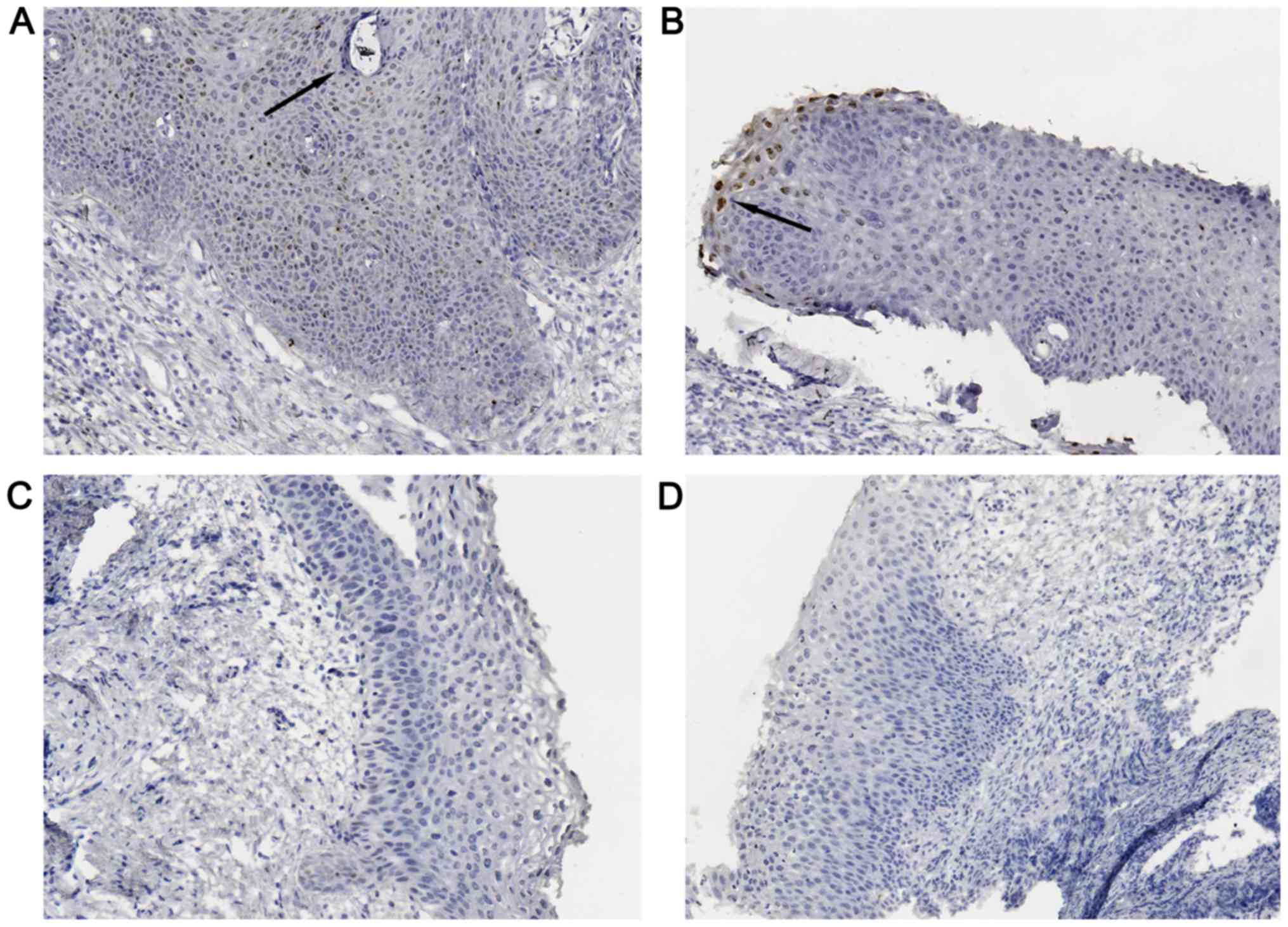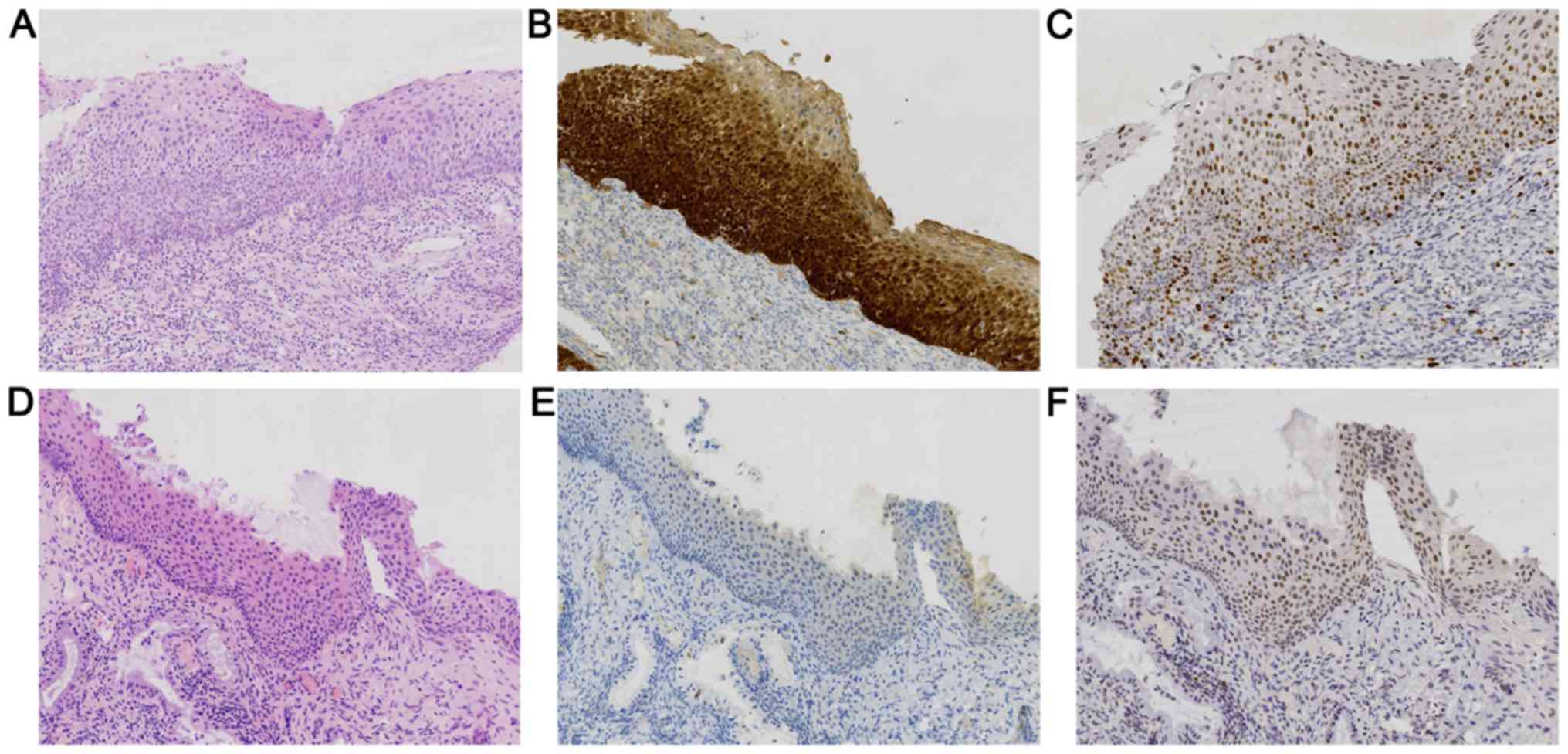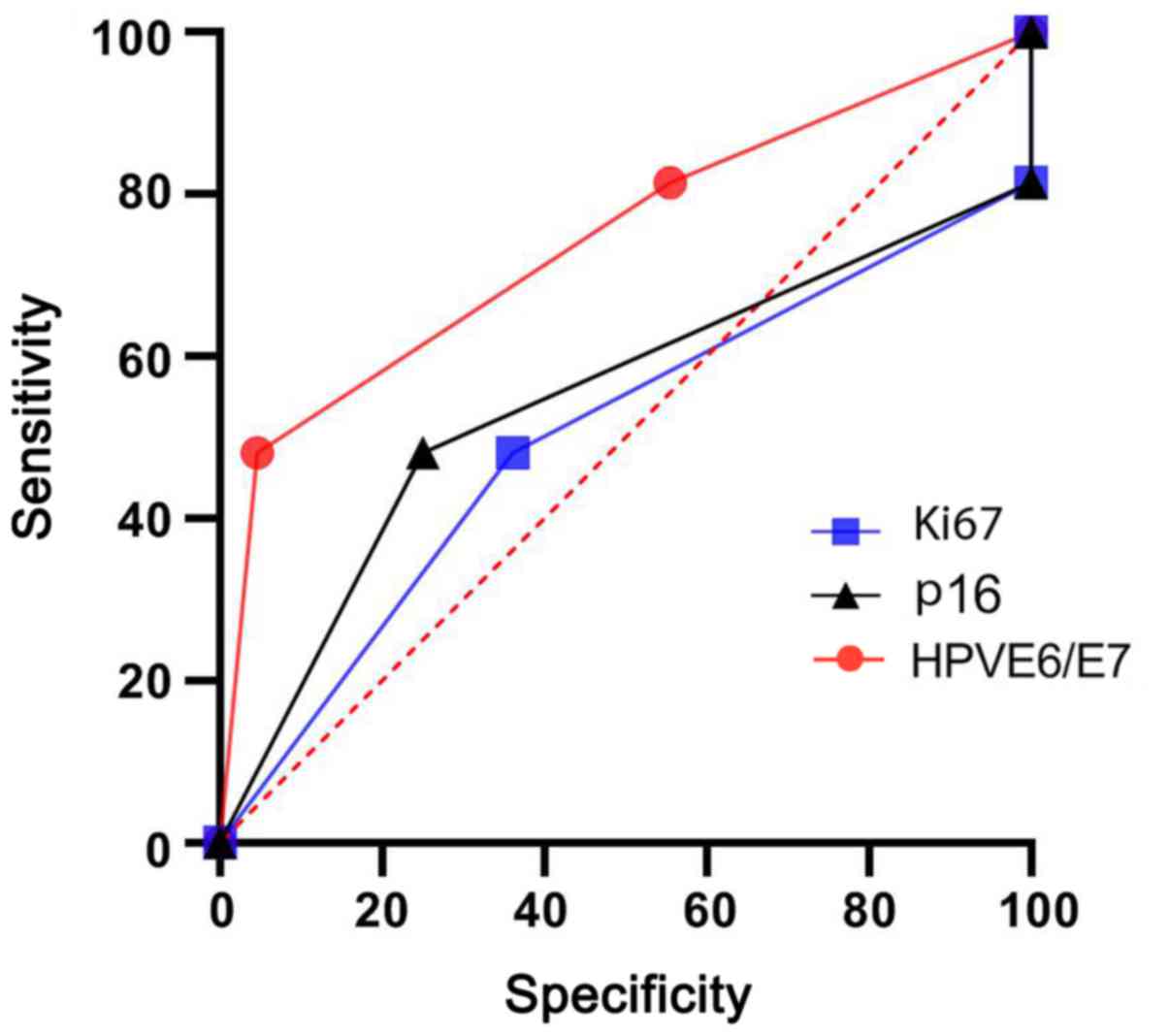|
1
|
Christoph G, Stephan P, Camilla N, Rahhal
J, Hefler L, Tempfer CB, Heinze G, Stary G, Reinthaller A and
Speiser P: Treatment of cervical intraepithelial neoplasia with
topical imiquimod: A randomized controlled trial. Obstet Gynecol.
120:152–159. 2012. View Article : Google Scholar : PubMed/NCBI
|
|
2
|
Aps G, Mag G and Da-Silva VD: Evaluation
of Telomerase (hTert), Ki67 and p16ink4a expressions in low and
high-grade cervical intraepithelial lesions. Rev Col Bras Cir.
44:131–139. 2017.(In English, Portuguese). View Article : Google Scholar : PubMed/NCBI
|
|
3
|
Koeneman MM, Roy Fpm K, Nijman HW,
Brigitte Fm S, Toon VG and Arnold-Jan K: Natural history of
high-grade cervical intraepithelial neoplasia: A review of
prognostic biomarkers. Expert Rev Mol Diagn. 15:5272015. View Article : Google Scholar : PubMed/NCBI
|
|
4
|
Xu QX and Zhang ZY: High-risk Human
papillomavirus genotypes in cervical lesions and vaccination
challenges in China. Asian Pac J Cancer Prev. 16:2193–2197. 2015.
View Article : Google Scholar : PubMed/NCBI
|
|
5
|
Evans MF, Peng Z, Clark KM, Adamson CSC,
Ma XJ, Wu X, Wang H, Luo Y and Cooper K: HPV E6/E7 RNA in situ
hybridization signal patterns as biomarkers of three-tier cervical
intraepithelial neoplasia grade. PLoS One. 9:e911422014. View Article : Google Scholar : PubMed/NCBI
|
|
6
|
Mirghani H, Casiraghi O, Amen F, He M, Ma
XJ, Saulnier P, Lacroix L, Drusch F, Lakdhar A and Saint Guily JL:
Diagnosis of HPV-driven head and neck cancer with a single test in
routine clinical practice. Mod Pathol. 28:1518–1527. 2015.
View Article : Google Scholar : PubMed/NCBI
|
|
7
|
Mirghani H, Casiraghi O, Guerlain J, Amen
F, He MX, Ma XJ, Luo Y, Mourareau C, Drusch F, Lakdhar AB, et al:
Diagnosis of HPV driven oropharyngeal cancers: Comparing p16 based
algorithms with the RNAscope HPV-test. Oral Oncology. 62:101–108.
2016. View Article : Google Scholar : PubMed/NCBI
|
|
8
|
Mills AM, Dirks DC, Poulter MD, Mills SE
and Stoler MH: HR-HPV E6/E7 mRNA in situ hybridization: Validation
against PCR, DNA in situ hybridization, and p16
immunohistochemistry in 102 samples of cervical, vulvar, anal, and
head and neck Neoplasia. Am J Surg Pathol. 41:607–615. 2017.
View Article : Google Scholar : PubMed/NCBI
|
|
9
|
Loopik DL, Doucette S, Bekkers RL and
Bentley JR: Regression and progression predictors of CIN2 in women
younger than 25 years. J Low Genit Tract Dis. 20:213–217. 2016.
View Article : Google Scholar : PubMed/NCBI
|
|
10
|
Darragh TM, Colgan TJ, Cox TJ, Heller DS,
Henry MR, Luff RD, McCalmont T, Nayar R, Palefsky JM, Stoler MH, et
al: The lower anogenital squamous terminology standardization
project for HPV-associated lesions: Background and consensus
recommendations from the College of American Pathologists and the
American Society for Colposcopy and Cervical Pathology. Int J
Gynecol Pathol. 32:76–115. 2013. View Article : Google Scholar : PubMed/NCBI
|
|
11
|
Christine B, Guglielmo R, Miriam R,
Nicolas W, Marc A, Mark S and Magnus von Knebel D: The clinical
impact of using p16(INK4a) immunochemistry in cervical
histopathology and cytology: An update of recent developments. Int
J Cancer. 136:2741–2751. 2015. View Article : Google Scholar : PubMed/NCBI
|
|
12
|
Xiaobo Z and Danhua S: p16INK4a and Ki-67
measurement predict progression of cervical low-grade squamous
intraepithelial lesion. Int J Clin Exp Pathol. 11:4109–4116.
2018.PubMed/NCBI
|
|
13
|
Wilbur DC and Nayar R: The Bethesda system
for reporting cervical cytology: A historical perspectiv. Acta
Cytologica. 61:359–372. 2017. View Article : Google Scholar : PubMed/NCBI
|
|
14
|
Tainio K, Athanasiou A, Tikkinen KAO,
Aaltonen R, Cárdenas J, Hernándes, Glazer-Livson S, Jakobsson M,
Joronen K, Kiviharju M, et al: Clinical course of untreated
cervical intraepithelial neoplasia grade 2 under active
surveillance: Systematic review and meta-analysis. BMJ.
360:k4992018. View
Article : Google Scholar : PubMed/NCBI
|
|
15
|
Miralpeix E, Genovés J, Maria SSJ, Mancebo
G, Lloveras B, Bellosillo B, Alameda F and Carreras R: Usefulness
of p16INK4a staining for managing histological
high-grade squamous intraepithelial cervical lesions. Mod Pathol.
30:304–310. 2016. View Article : Google Scholar : PubMed/NCBI
|
|
16
|
Tavassoéli FA and Devilee P: Pathology and
genetics of tumours of the breast and female genital organs.
(Lyon). World Health Organization Classification of Tumors.
4322003.
|
|
17
|
Kurman RJ, Carcangiu ML, Herrington CS and
Young RH: WHO classification of tumous of female reproductive
organs. (Fourth edition). 3072014.
|
|
18
|
Miyamoto S, Hasegawa J, Morioka M, Hirota
Y, Kushima M and Sekizawa A: The association between p16 and Ki-67
immunohistostaining and the progression of cervical intraepithelial
neoplasia grade 2. Int J Gynaecol Obstet. 134:45–48. 2016.
View Article : Google Scholar : PubMed/NCBI
|
|
19
|
Maniar KP, Sanchez B, Paintal A, Gursel DB
and Nayar R: Role of the biomarker p16 in downgrading-IN 2
diagnoses and predicting higher-grade lesions. Am J Surg Pathol.
39:1708–1718. 2015. View Article : Google Scholar : PubMed/NCBI
|
|
20
|
Nuño T and García F: The lower anogenital
squamous terminology project and its implications for clinical
care. Obstet Gynecol Clin North Am. 40:225–233. 2013. View Article : Google Scholar : PubMed/NCBI
|
|
21
|
Galgano MT, Castle PE, Atkins KA, Brix WK,
Nassau SR and Stoler MH: Using biomarkers as objective standards in
the diagnosis of cervical biopsies. Am J Surg Pathol. 34:1077–1087.
2010. View Article : Google Scholar : PubMed/NCBI
|
|
22
|
Guang-Dong L, Sellors JW, Hai-Kui S, Xun
Z, Yan-Ping B, Jose J, Wen C, Fang-Hui Z, Yan S, Zhi C, et al:
p16INK4A immunohistochemical staining and predictive value for
progression of cervical intraepithelial neoplasia grade 1: A
prospective study in China. Int J Cancer. 134:1715–1724. 2014.
View Article : Google Scholar : PubMed/NCBI
|
|
23
|
Maryam R, Andrée S, Oligny LL, Patey N,
Dormoy-Raclet V, Ducruet T and Bouron-Dal Soglio D: Assessment of
correlation between p16INK4a staining, specific subtype of human
papillomavirus, and progression of LSIL/CIN1 lesions: First
comparative study. Am J Clin Pathol. 142:104–110. 2014. View Article : Google Scholar : PubMed/NCBI
|
|
24
|
Sun L, Zhang L, Krigman HR and Hagemann
IS: p16 immunohistochemistry is not always required for accurate
diagnosis of grade 2 squamous intraepithelial lesions. J Low Genit
Tract Dis. 22:104–109. 2018. View Article : Google Scholar : PubMed/NCBI
|
|
25
|
Fan Y and Shen Z: The clinical value of
HPV E6/E7 and STAT3 mRNA detection in cervical cancer screening.
Pathol Res Pract. 214:767–775. 2018. View Article : Google Scholar : PubMed/NCBI
|
|
26
|
Gernot H, Mahmood M, Kerstin ID,
Pischinger, Thomas WR, Christian FS, Kubista E and Czerwenka KF:
Physical state and expression of HPV DNA in benign and dysplastic
cervical tissue: Different levels of viral integration are
correlated with lesion grade. Gynecol Oncol. 92:873–880. 2004.
View Article : Google Scholar : PubMed/NCBI
|
|
27
|
Holm R, Kraus I, Skomedal H, Langerød A,
Kristensen GB and Lyng H: Human papillomavirus DNA and e6/e7 mRNA
status in relation to survival of patients treated for cervical
squamous cell carcinoma. Open Virol J. 2:74–81. 2008. View Article : Google Scholar : PubMed/NCBI
|
|
28
|
Frega A, Sesti F, Lombardi D, Votano S,
Sopracordevole F, Catalano A, Milazzo GN, Lombardo R, Assorgi C,
Olivola S, et al: Assessment of HPV-mRNA test to predict recurrent
disease in patients previously treated for CIN 2/3. J Clin Virol.
60:39–43. 2014. View Article : Google Scholar : PubMed/NCBI
|
|
29
|
Coquillard G, Palao B and Patterson BK:
Quantification of intracellular HPV E6/E7 mRNA expression increases
the specificity and positive predictive value of cervical cancer
screening compared to HPV DNA. Gynecol Oncol. 120:89–93. 2011.
View Article : Google Scholar : PubMed/NCBI
|
|
30
|
Steenbergen RDM, Snijders PJF, Heideman
DLAM and Meijer CJLM: Clinical implications of (Epi)genetic changes
in HPV-induced cervical precancerous lesions. Nat Rev Cancer.
14:395–405. 2014. View
Article : Google Scholar : PubMed/NCBI
|
|
31
|
Baak JPA, Arnold-Jan K, Garland SM,
Skaland I, Janssen EAM, Tabrizi S, Fagerheim S, Robboy S and Nilsen
ST: Combined p53 and retinoblastoma protein detection identifies
persistent and regressive cervical high-grade squamous
intraepithelial lesions. Am J Surg Pathol. 29:1062–1066.
2005.PubMed/NCBI
|

















